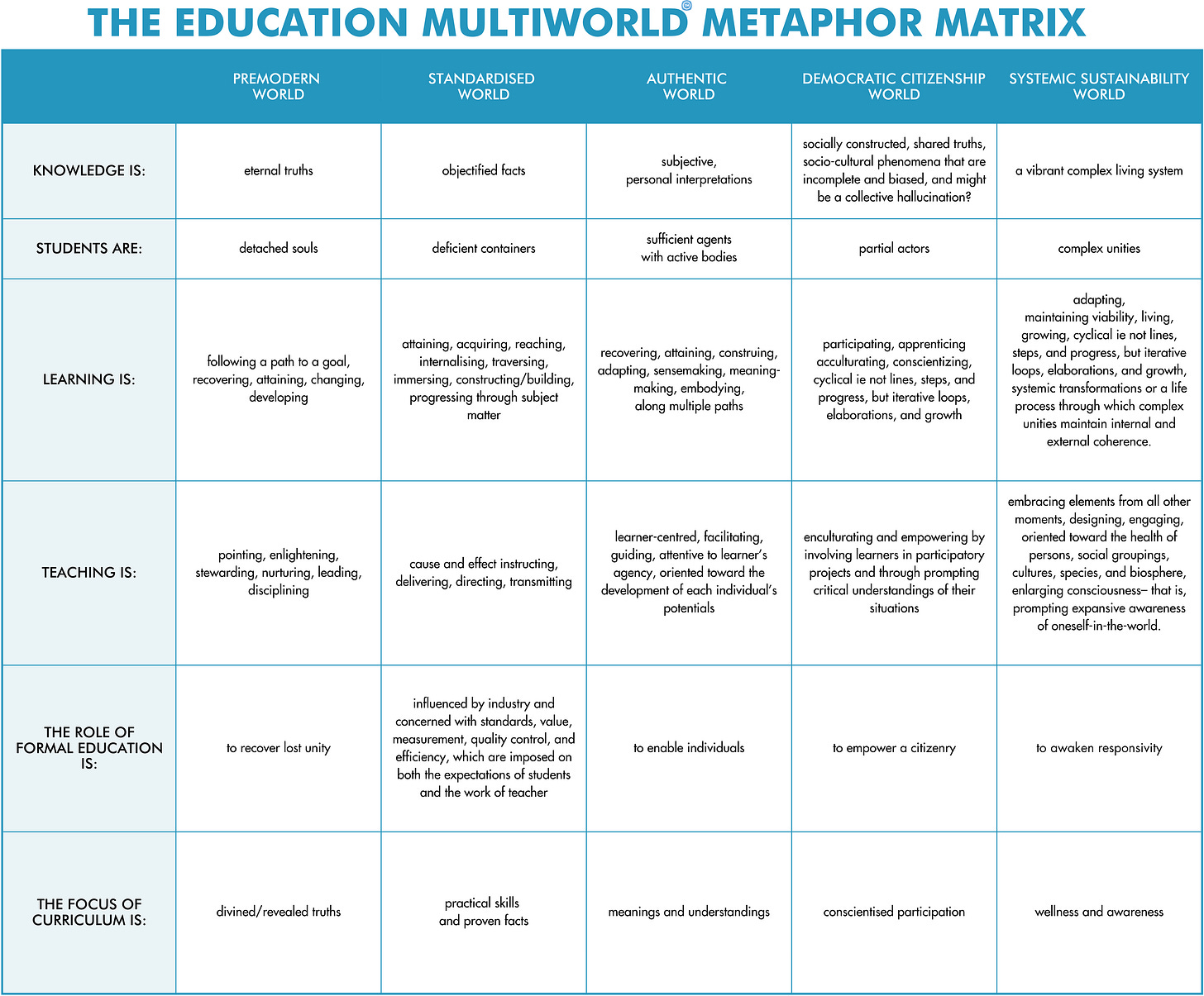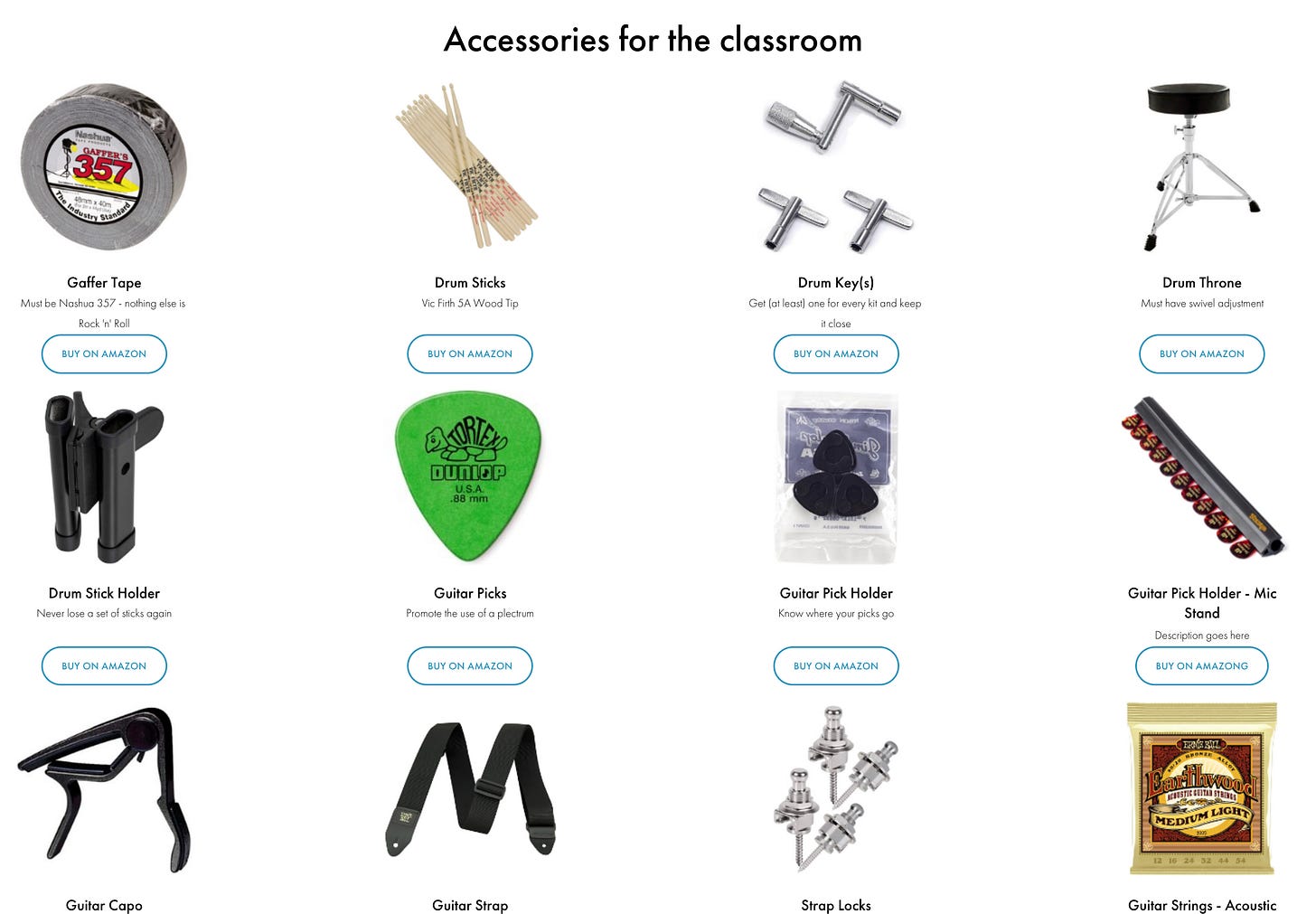Don’t You Dare Close Your Eyes!
In our last post I revealed that we’re living in an Education Multiworld™ and finished with the question: “So, how’s your education world?”. Maybe you’re like me back in the 90s with Jeremy Alsop and you’re thinking: “I have a world?”. Or maybe you already had a world but this Education Multiworld™ concept has blown your mind and you’re desperate to know more? Well, what if I told you that, just like Peabo Bryson in the closing credits of the Disney animated classic Aladin: “I can show you the world” or worlds and maybe even introduce you to “a whole new world”, or two. So “don’t you dare close your eyes”.
Revealing the Five Worlds
Returning to the five worlds of the Education Multiworld™ revealed in Davis and Francis’ fourth edition of Engaging Minds:
Premodern Education - 3000 BCE (updated title circa 2023 website)
Standardised Education - 1600s
Authentic Education - early 1900s
Democratic Citizenship Education - 1960s
Systemic Sustainability Education - 1990s (p. i)
I’ll show you how to develop a Worldview X-ray Vision™ “superpower” that will equip you to “see through” the words people use to talk about knowledge, learning, and teaching to “unveil” their education world. This is crucial because it’s likely that conversations between inhabitants of different worlds of the Education Multiworld™ are lost in translation, making it almost impossible to have a shared understanding about what is worth knowing, what good teaching is, and what it means for students to learn, to name just a few big questions. This superpower won’t just allow you to position others though, you can also use this power on your own language and slide into philosophy to find a whole new world or worlds of education for you and your students.
What’s a Metaphor For?
The key to unlocking our Worldview X-ray Vision™ is to understand the role of metaphors. While humans are capable of logical reasoning, we generally default to analogical reasoning through the use of metaphors. Indeed the word metaphor is a metaphor, coming from the Greek meta + pherein meaning “to carry across”. For example “learning is grasping” carries across the “simple act of a grabbing an object to the complex event of transforming understanding” (Davis & Francis, 2018, p. 11).
So, each era of education has a dominant paradigm with “clouds” of associated icons, metaphors and language that guide the action of a community of specialists. Davis and Francis maintain that:
metaphors pervade though and influence action, similarly, each synonym for teaching is both a description and a prescription. That is, each point to both a theory (i.e., literally, a ‘way of seeing’) and a practice. And, “every metaphor of knowledge triggers its own cascade of consequences and associations”. (Davis and Francis, 2022, p. 48)
As an example, look at this “cascade of entailments”:
Knowledge is an object →
Learning is acquiring →
Learners are repositories (p. 48) →
This cascade leads to the prescription that:
Teaching is depositing objects into imperfect receptacles (Davis, 2018, p. 183)
While these clouds of metaphors are often implicit or invisible, they frame the discourse of each education world. So, the next step in unlocking our Worldview X-ray Vision™ is to “see” each world’s metaphors and make the implicit explicit by learning to identify the discourse or the shared language associated with each world. Based on Engaging Minds and its associated website, learningdiscourses.com I’ve compiled a hitlist for each world. Let’s begin by meeting educators from each world:
1. Premodern World - 3000 BCE
Premodern Educators (PEs) inhabit a world carved out of traditions inherited from the ancient Greek Academy, the medieval university, and the early parochial (or parish) schools. They are devoted to order and believe truth is eternal, universal, and independent of human existence. Their metaphor is clear direction and the “straight and narrow,” avoiding deviations and deflections (i.e., anything off the line) (Davis & Francis, 2023). Their approach to teaching is mainly about helping individuals to understand their place in the universe. (2022, p. 5).
2. Standardised World - 1600s
Standardised Educators (SEs) inhabit a world that emphasises common programs of study, age-based grade levels, and uniform performance outcomes. They draw much of their inspiration and content from ancient traditions and religion, but their main influences are industry and the physical sciences. Their approach to teaching focuses on facts and skills, and is modeled after working on a factory line. (2022, p. 5).
3. Authentic World
Authentic Educators (AEs) inhabit a world rooted in the human sciences and emphasise personal engagement, learner difference, developmental stages, and personalised learning aligned with individual curiosities and goals. Their classroom approaches are based in reality, focused on understanding, and rich with inquiry. Their teaching is less directive and more attentive to individuals (2022, p.5).
4. Democratic Citizenship World
Democratic Citizenship Educators (DCEs) live in a world Informed mainly by the social sciences. They emphasise emancipation, empowerment, and voice, in schools which are democratically governed by students who also have autonomy in managing their own learning. DCEs aim to promote social justice and productive collective action through recognising and (where appropriate) subverting hegemonic structures. They see teaching as preparing students to contribute to a better society by addressing cultural inequities and suppressions through raising awarenesses (2022, p. i).
5. Systemic Sustainability World
Systemic Sustainability Educators (SSEs) inhabit a global, complex ecosystem and believe that formal schooling has been too narrowly focused on humanity – with an either-or approach to individuals and society. They are concerned with educating global citizens with knowledge of political and ecological issues who have the skills, attitudes, and dispositions to participate mindfully in efforts to affect the world in ways that are ecologically sustainable. SSEs look beyond traditional and assumed borders or boundaries and hope to enable and promote interactions between diverse peoples and ideas. They see teaching as raising awareness of and developing effective responses to social, cultural, and ecological issues arising from environmental challenges associated with human activity that move us toward an “ecologically-minded and information-based society” (2022, p.5).
So What Is Knowledge, Learning and Teaching?
So, what does uncovering these worlds and worldviews mean for the humble classroom music teacher’s understanding of knowledge, learning, and teaching. It means that these matters are not settled (2022, p. 40), they are essentially contested concepts. Davis and Francis remind us that:
Our conception of teaching is that of the dominant culture. A sign of the privilege of the dominant culture is a freedom from having to be explicit about assumptions - or, for that matter, even to be aware of them. That's because the traditions and beliefs of the dominant culture are allowed to serve as the normal, commonsensical backdrop. (2022, p. 40)
They argue that although Standardised Education has had decades of “extensive criticisms”, it “continues to prevail”, held in place by the
familiarity of practice,
uncritical beliefs about learning,
oppressive regimes of examination,
its momentum (p. 40).
They remind us that:
It is difficult to conceive of education in terms that depart far from the implicit ideals of objective knowledge, standardised outputs and efficient productivity. No other frame of formal education is so well fitted to the scientised and commercialised culture in which schools must operate. (p. 40)
Clearly, it’s time to slide into philosophy.
Worldview X-ray Vision™ - Your Discourse Analysis Super Power
To help us to reveal assumptions and potentially communicate across the Education Multiworld, I’ve created the Education Multiworld Metaphor Matrix. The matrix is adapted from various tables developed by Brent Davis over the last 20 years and draws heavily on a table in the 4th edition of Engaging Minds and information at learningdiscourses.com.
Next time you slide into philosophy, use the matrix to help you to unveil your cascade of entailments and/or interrogate the language used in the educational discourse in your community. The matrix can also be employed with the Septem Circumstantiae whenever colleagues, bosses, politicians etc start spruiking “best” teaching practices or argue for more empirical research, to unveil their assumptions about “best where, when, and for whom” (2002, p. 10) etc. Davis and Francis argue that “even evidently scientific discourses on learning are riddled with unexplicated, often naïve, and occasionally problematic metaphors” (p. 13).
As we develop our Worldview X-ray Vision, it can help us to understand each other and begin to see how a logical entailment in one world could be completely nonsensical in another. Crucially, for classroom music teachers providing Gig Based Learning opportunities, the world our classroom inhabits might either nurture or reject our approach. Being able to speak across world’s might help us to create more helpful cascades of entailments for ourselves and also, perhaps allow us to translate our work for bosses and other power brokers. Remember, these metaphors are descriptions AND prescriptions. Unlocking a new world doesn’t just open our minds to new possibilities to talk about knowledge, learning, and teaching, it opens up new possibilities for action - new ways to learn, new ways to teach, and potentially gives new, broader, and perhaps even more inspiring purpose\s for our work in the music classroom. This is a big deal!
I’ve just scratched the surface of Brent Davis’ work in this post. If it’s ignited a spark for you, you’ll love Inventions of Teaching, and Engaging Minds, and you might even be brave enough to eventually tackle learningdiscourses.com - just make sure you watch the orientation video first - that map is a doozy! Let me know if you do and I’ll join you on the magic carpet ride…
I’ll sign off with a personalised provocation from Davis and Francis:
The evolution of [your] new horizons of educational possibility might be better served by efforts to understand the current discursive landscape than by claiming and defending patches of [your] terrain. (2022, p. 13)
💎 Brad’s Bookmarks:
5 things I found interesting this week:
I love these guys. Eye of the tiger | funk cover by Scary Pockets. Link
This is a really interesting gig idea for students. Limit them to a certain amount/style of gear. Thanks Andrew Huang & Rob Scallon. Link
ISME just posted a video on AI that has gone viral (for music education = 30 views worldwide!). Link
Seriously so cool. I’d be screaming too. BO DIDDLEY 1965. Link
All Blues!! How Pink Floyd used this Miles Davis chord. Link
💣 Brad’s Bombshell of the week:
“Nevertheless, instead of engaging in the thoughtful diagnosis of local conditions and ofthe philosophy needed to "write curriculum," many music teachers instead adopt this or that technicist method as the curriculum and proceed to teach it-the "method"-in the name of "curriculum"!
The problem is not that the tools (the teaching strategies, activities, lessons, materials, and so on) are necessarily faulty. Rather, the problem is the technicist assumption that the tools are "the curriculum" by themselves, regardless of what they may or may not regularly produce!
In fact, many of the tools of such methods can often be detached from slavish technicism.
In music teaching a wealth of tools exists that can be mindfully used when guided by valid curricular outcomes and professional accountability for right results.” (Thomas A. Regelski, 2002)
P.S:
One of the most common questions I get:
How do I know what gear to buy for my music classroom?
Well, I use the gear on the GBL '“Gear We Dig” page. It’s all there!
BTW our community of practitioners have been chatting classroom music room setups.
Thanks for reading this week’s newsletter
I also read every comment on our YouTube. So, see you there.
Dr Brad Fuller







